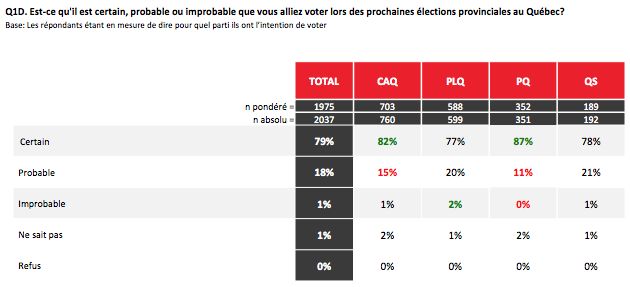My God, was it time or what?!? As Bryan Breguet put it on Twitter while awaiting the Léger results:
Juste une observation générale mais quand il y a davantage de personnes/sites faisant des projections que de firmes offrant des sondages, c’est pas vraiment normal1.
Thank goodness, this morning, Léger released the full report of its latest poll, conducted between 7 and 10 September!
I’m waiting to get my hands on the Mainstreet report for the poll conducted 5 to 7 September to update the voting intentions chart since I need the figures before allocating the undecided. At the moment, I only have the Le Soleil article, which only gives the results after distribution.
We can nevertheless update our voter volatility charts:
Voter volatility is fairly stable. The share of voters whose choice is definitive amongst those who have made a choice has gone from 56% to 58% in the span of a fortnight.
The results broken down by party are more revealing:
Voting intentions for the Parti Québécois seem to be going up, with a two-percentage-point increase over the last two weeks (19% to 21% once the undecided are allocated). However, the PQ has slipped from the party with the least wavering electorate to the second to last amongst the Big Four.
Indeed, in the poll that ran until 28 August, 64% of people who intended to vote for the PQ considered that their choice was definitive. In yesterday’s poll, that proportion was down to 54%. Jean-François Lisée’s party is the only to have seen its voters’ volatility increase!
Do these results mean that people who are moving back and forth between the PQ and the CAQ are now saying that they will vote PQ, but that they might still change their minds?
To figure that out, we’ll have to dig into answers to the question related to alternative choices… to be continued!
Source data
You can access the spreadsheet from which the charts were generated on Google Spreadsheets.


